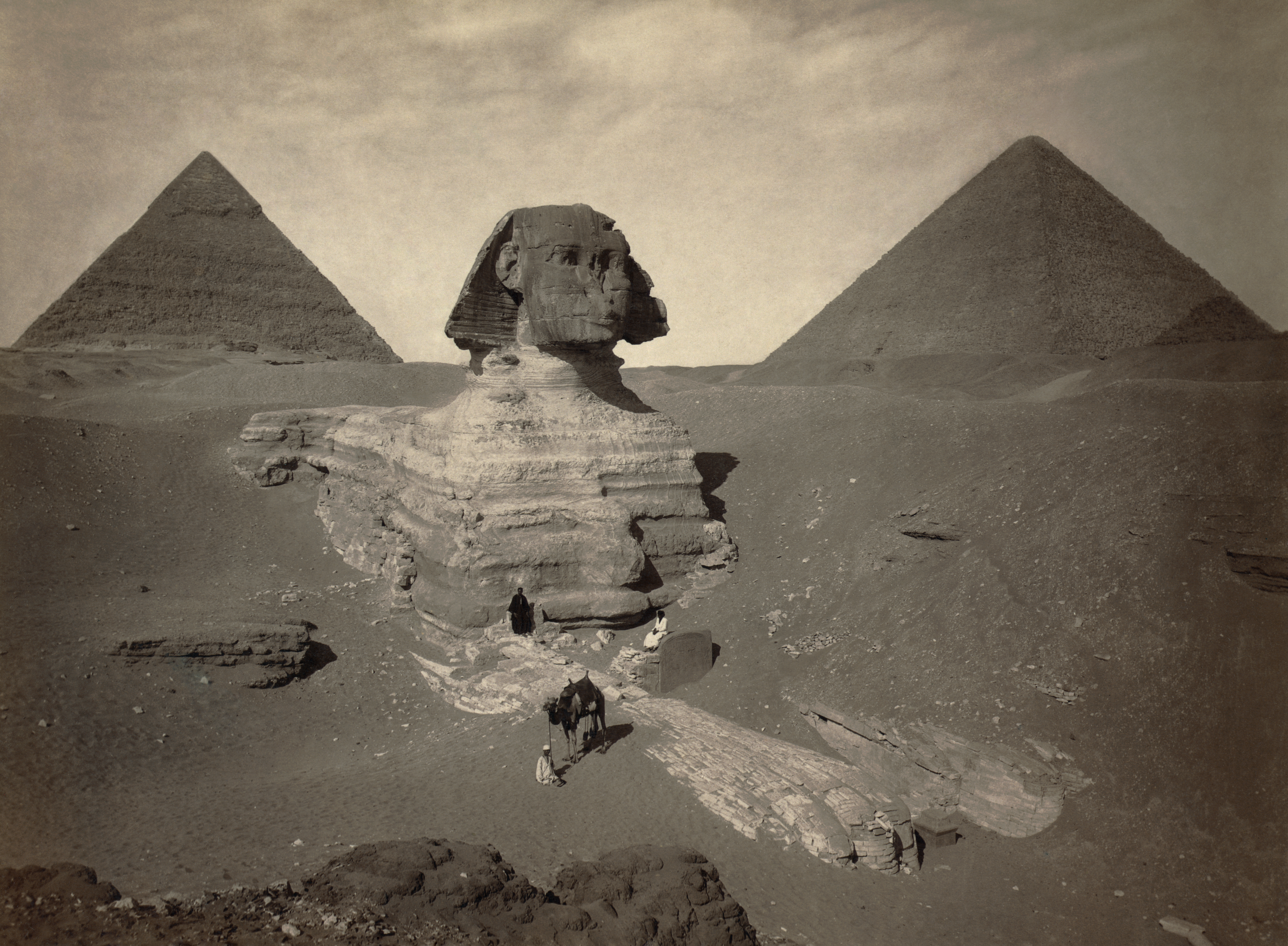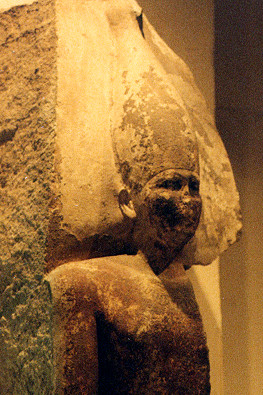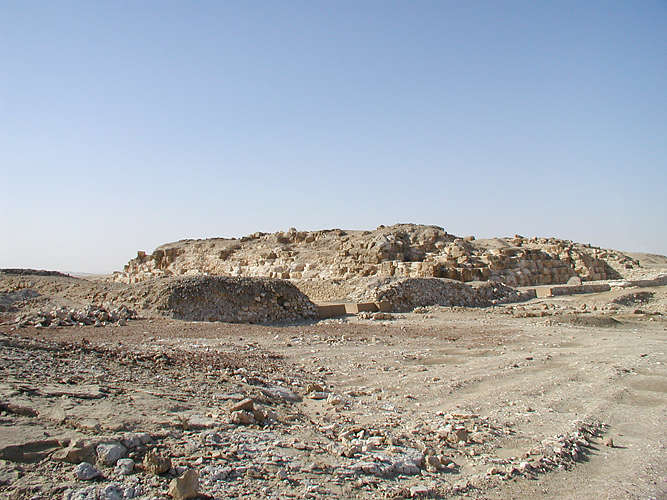|
Giza Necropolis
The Giza pyramid complex (also called the Giza necropolis) in Egypt is home to the Great Pyramid, the pyramid of Khafre, and the pyramid of Menkaure, along with their associated pyramid complexes and the Great Sphinx. All were built during the Fourth Dynasty of the Old Kingdom of ancient Egypt, between . The site also includes several temples, cemeteries, and the remains of a workers' village. The site is at the edge of the Western Desert, approximately west of the Nile River in the city of Giza, and about southwest of the city centre of Cairo. It forms the northernmost part of the Pyramid Fields of the Memphis and its Necropolis UNESCO World Heritage Site, inscribed in 1979. The pyramid fields include the Abusir, Saqqara, and Dahshur pyramid complexes, which were all built in the vicinity of Egypt's ancient capital of Memphis. Further Old Kingdom pyramid fields were located at the sites Abu Rawash, Zawyet El Aryan, and Meidum. Most of the limestone used to build ... [...More Info...] [...Related Items...] OR: [Wikipedia] [Google] [Baidu] |
Western Desert (Egypt)
In Egypt, the Western Desert is an area of the Sahara that lies west of the river Nile, up to the Egypt–Libya border, Libyan border, and south from the Mediterranean Sea to the Egypt–Sudan border, border with Sudan. It is named in contrast to the Eastern Desert which extends east from the Nile to the Red Sea. The Western Desert is mostly Reg (landform), rocky desert, though an area of Erg (landform), sandy desert, known as the Great Sand Sea, lies to the west against the Libyan border. The desert covers an area of which is two-thirds of the land area of the country. Its highest elevation is in the Gilf Kebir plateau to the far south-west of the country, on the Egypt-Sudan-Libya border. The Western Desert is barren and uninhabited save for a chain of oases which extend in an arc from Siwa Oasis, Siwa, in the north-west, to Kharga in the south. It has been the scene of conflict in modern times, particularly during the Second World War. Administratively the Western Desert is d ... [...More Info...] [...Related Items...] OR: [Wikipedia] [Google] [Baidu] |
Giza, Greater Cairo
Giza (; sometimes spelled ''Gizah, Gizeh, Geeza, Jiza''; , , ' ) is the list of cities and towns in Egypt, third-largest city in Egypt by area after Cairo and Alexandria; and List of cities in Africa by population, fourth-largest city in Africa by population after Kinshasa, Lagos, and Cairo. It is the capital of Giza Governorate with a total population of 4,872,448 in the 2017 census. It is located on the west bank of the Nile opposite central Cairo, and is a part of the Greater Cairo metropolis. Giza lies less than north of Memphis, Egypt, Memphis (''Men-nefer,'' today the village of Mit Rahina), which was the capital city of the unified Egyptian state during the reign of pharaoh Narmer, roughly 3100 BC. Giza is most famous as the location of the Giza Plateau, the site of some of the most impressive ancient monuments in the world, including a complex of ancient Egyptian royal mortuary and sacred structures, among which are the Great Sphinx, the Great Pyramid of Giza, and a n ... [...More Info...] [...Related Items...] OR: [Wikipedia] [Google] [Baidu] |
Fourth Dynasty Of Egypt
The Fourth Dynasty of ancient Egypt (notated Dynasty IV) is characterized as a "golden age" of the Old Kingdom of Egypt. Dynasty IV lasted from to c. 2498 BC. It was a time of peace and prosperity as well as one during which trade with other countries is officially documented. The Fourth Dynasty heralded the height of the pyramid-building age. The peaceful rule of the Third Dynasty of Egypt, Third Dynasty allowed artistic expressions to flourish. Building experiments done by King Sneferu led to the evolution of mastaba tombs into the smooth sided pyramids like those seen on the Giza Plateau. No other period in Egyptian history equaled the accomplishments achieved during the Fourth Dynasty.Egypt: Land and Lives of the Pharaohs Revealed, (2005), pp. 80–90, Global Book Publishing: Australia Rulers Summary of Listed Kings Sneferu Sneferu, lauded as "Bringer of Beauty", "Master of All Justice", and "Ruler of Lower and Upper Nile", was the first pharaoh of the fourt ... [...More Info...] [...Related Items...] OR: [Wikipedia] [Google] [Baidu] |
Abu Rawash
Abu Rawash (also spelled ''Abu Roach'', Abu Roash; , , , "flesh of sensual pleasures"), north of Giza, is the site of Egypt's most northerly pyramid, also known as the lost pyramid – the mostly ruined Pyramid of Djedefre, the son and successor of Khufu. Originally, it was thought that this pyramid had never been completed, but the current archaeological consensus is that not only was it completed, but that it was built about the same size as the Pyramid of Menkaure – the third largest of the Giza pyramids. It's believed that the destruction of the pyramid started at the end of the New Kingdom of Egypt, New Kingdom at the latest, and was particularly intense during the Roman and early Christian eras when Wadi El Natrun#Invasion of Scetis, a Coptic monastery was built in nearby Wadi El Natrun, Wadi Karin. It has been proven, moreover, that at the end of the nineteenth century, stone was still being hauled away at the rate of three hundred camel loads a day. I ... [...More Info...] [...Related Items...] OR: [Wikipedia] [Google] [Baidu] |
Memphis, Egypt
Memphis (, ; Bohairic ; ), or Men-nefer, was the ancient capital of Inebu-hedj, the first Nome (Egypt), nome of Lower Egypt that was known as ''mḥw'' ("North"). Its ruins are located in the vicinity of the present-day village of Mit Rahina (), in markaz (county) Badrashin, Giza, Egypt. Along with the Memphite Necropolis, pyramid fields that stretch on a desert plateau for more than on its west, including the famous Giza pyramid complex, Pyramids of Giza, Memphis and its necropolis have been listed as a World Heritage Site. The site is open to the public as an open-air museum. According to legends related in the early third century BC by Manetho, a priest and historian who lived in the Ptolemaic Kingdom during the Hellenistic period of ancient Egypt, the city was founded by Pharaoh, King Menes. It was the List of Egyptian capitals, capital of ancient Egypt (''Kemet'' or ''Kumat'') during both the Early Dynastic Period of Egypt, Early Dynastic Period and Old Kingdom and remain ... [...More Info...] [...Related Items...] OR: [Wikipedia] [Google] [Baidu] |
Dahshur
DahshurAlso transliterated ''Dahshour'' (in English often called ''Dashur''; ' ) is an ancient Egyptian pyramid complex and necropolis and shares the name of the nearby village of Manshiyyat Dahshur () in markaz Badrashin, Giza Governorate, Giza. Dahshur is listed as a UNESCO World Heritage Site, and is located on the Western Desert (Egypt), Western Desert plateau at the edge of the cultivated plain, and along with the pyramid complexes at Saqqara, Abusir, and Giza pyramid complex, Giza, to its north, forms the Memphite Necropolis, pyramid fields of the ancient capital city of Memphis, Egypt, Memphis. It is known chiefly for several pyramids, mainly Sneferu, Sneferu's Bent Pyramid and the Red Pyramid, which are among the oldest, largest and best preserved in Egypt, built from 2613 to 2589 BC. Pyramids The Dahshur pyramids were an extremely important learning experience for the Egyptians. It provided them with the knowledge and know-how to transition from step-sided pyramids ... [...More Info...] [...Related Items...] OR: [Wikipedia] [Google] [Baidu] |
Saqqara
Saqqara ( : saqqāra[t], ), also spelled Sakkara or Saccara in English , is an Egyptian village in the markaz (county) of Badrashin in the Giza Governorate, that contains ancient burial grounds of Egyptian royalty, serving as the necropolis for the ancient Egyptian capital, Memphis, Egypt, Memphis. Saqqara contains numerous pyramids, including the Pyramid of Djoser, sometimes referred to as the Step Pyramid, and a number of mastaba tombs. Located some south of modern-day Cairo, Saqqara covers an area of around . Saqqara contains the oldest complete stone building complex known in history, the Pyramid of Djoser, built during the Third Dynasty of Egypt, Third Dynasty. Another sixteen Egyptian kings built pyramids at Saqqara, which are now in various states of preservation. High officials added private funeral monuments to this necropolis during the entire History of ancient Egypt, Pharaonic period. It remained an important complex for non-royal burials and cult ceremonies for more ... [...More Info...] [...Related Items...] OR: [Wikipedia] [Google] [Baidu] |
Abusir
Abusir ( ; Egyptian ''pr wsjr'' ' "the resting place of Osiris"; ) is the name given to an ancient Egyptian archaeological pyramid complex comprising the ruins of 4 kings' pyramids dating to the Old Kingdom period, and is part of the Pyramid Fields of the Memphis and its Necropolis UNESCO World Heritage Site. The pyramid complex is named after the neighbouring village of Abusir, in the markaz (county) of Badrashin, Giza. The Abusir pyramid complex is located on the Western Desert plateau at the edge of the cultivated plain, with the Giza Pyramids to its north, and Saqqara to its south, and served as one of the main elite cemeteries for the ancient Egyptian capital city of Memphis. Several other villages in northern and southern Egypt are named Abusir or Busiri. The locality of Abusir took its turn as the focus of the prestigious western burial rites operating out of the then-capital of Memphis during the Old Kingdom 5th Dynasty. As an elite cemetery, neighbou ... [...More Info...] [...Related Items...] OR: [Wikipedia] [Google] [Baidu] |
World Heritage Site
World Heritage Sites are landmarks and areas with legal protection under an treaty, international treaty administered by UNESCO for having cultural, historical, or scientific significance. The sites are judged to contain "cultural and natural heritage around the world considered to be of outstanding value to humanity". To be selected, a World Heritage Site is nominated by its host country and determined by the UNESCO's World Heritage Committee to be a unique landmark which is geographically and historically identifiable, having a special cultural or physical significance, and to be under a sufficient system of legal protection. World Heritage Sites might be ancient ruins or historical structures, buildings, cities, deserts, forests, islands, lakes, monuments, mountains or wilderness areas, and others. A World Heritage Site may signify a remarkable accomplishment of humankind and serve as evidence of humanity's intellectual history on the planet, or it might be a place of grea ... [...More Info...] [...Related Items...] OR: [Wikipedia] [Google] [Baidu] |
Memphite Necropolis
The Memphite Necropolis (or Pyramid Fields) is a series of Ancient Egypt, ancient Egyptian funerary complexes occupying a 30-kilometer (19 mi) stretch on the Western Desert (Egypt), Western Desert plateau near the ancient capital of Memphis, Egypt, Memphis (modern day Giza). It includes the pyramid complexes of Giza pyramid complex, Giza, Abusir, Saqqara and Dahshur and is recognized by UNESCO as a World Heritage Site. In addition to many of the Egyptian pyramids, pyramids of the Old Kingdom of Egypt, Old Kingdom, the necropolis is also populated with many tombs (e.g. Mastaba, mastabas), temples, and funerary artifacts. However, the site’s historical importance is not limited to these features. The necropolis also includes sites such as Heit al-Ghurab. Located in the southeastern area of the Giza Plateau, the site includes the village where craftsmen working on the tombs and pyramids would have lived. As a result of its status as physical and chronological behemoth, the Memphite N ... [...More Info...] [...Related Items...] OR: [Wikipedia] [Google] [Baidu] |
Downtown Cairo
Downtown Cairo ( "middle of town") is the colloquial name given to the 19th-century western expansion of Egypt's capital Cairo, between the historic medieval Cairo, and the Nile, which became the commercial center of the city during the 20th century. Given its rich architectural heritage from the era of Khedive Ismail, it has been officially named Khedival Cairo and declared by the government as a protected Area of Value, with many of its buildings also deemed protected. Administratively Wust al-Balad covers areas of qism Qasr al-Nil, and the Abdeen and Ezbekia districts. The protected Khedival Cairo covers a larger area extending south to Sayida Zeinab. History Downtown Cairo was designed by prestigious French architects who were commissioned by Khedive Ismail during his visit to Paris, and since then, he wanted to make the Egyptian Kingdom capital better than Paris and to be the jewel of the Orient. It was he who stressed the importance of European-style urban planning i ... [...More Info...] [...Related Items...] OR: [Wikipedia] [Google] [Baidu] |
Giza
Giza (; sometimes spelled ''Gizah, Gizeh, Geeza, Jiza''; , , ' ) is the third-largest city in Egypt by area after Cairo and Alexandria; and fourth-largest city in Africa by population after Kinshasa, Lagos, and Cairo. It is the capital of Giza Governorate with a total population of 4,872,448 in the 2017 census. It is located on the west bank of the Nile opposite central Cairo, and is a part of the Greater Cairo metropolis. Giza lies less than north of Memphis (''Men-nefer,'' today the village of Mit Rahina), which was the capital city of the unified Egyptian state during the reign of pharaoh Narmer, roughly 3100 BC. Giza is most famous as the location of the Giza Plateau, the site of some of the most impressive ancient monuments in the world, including a complex of ancient Egyptian royal mortuary and sacred structures, among which are the Great Sphinx, the Great Pyramid of Giza, and a number of other large pyramids and temples. Giza has always been a focal point in E ... [...More Info...] [...Related Items...] OR: [Wikipedia] [Google] [Baidu] |






